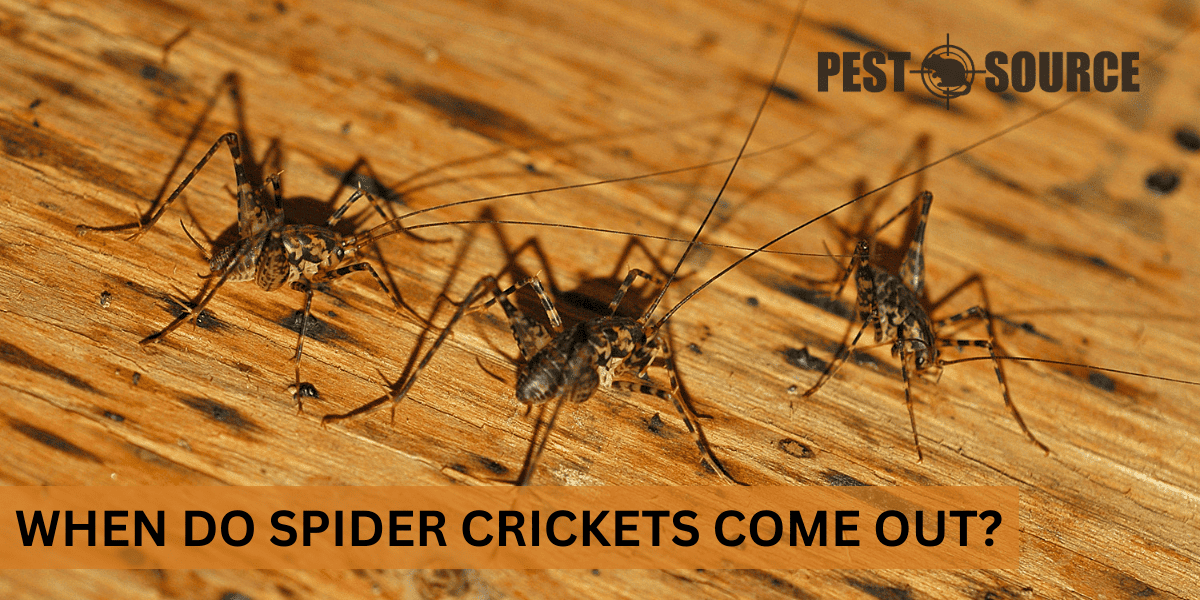Spider crickets are primarily nocturnal, becoming most active at night when they search for food and mates. Their nighttime activity is often unnoticed by homeowners. Understanding their behavior patterns is key to effectively managing and preventing infestations. This article will guide you through their habits and offer strategies to deal with their presence in your home.
POINTS
- Spider crickets are more visible and active during certain times of the year, particularly in the fall, and their lifecycle stages are influenced by environmental conditions like temperature and humidity.
- These pests are primarily nocturnal and their behavior is affected by weather patterns, habitat changes, and regional climates, with wet conditions leading to population increases.
- Predicting spider cricket emergence involves scientific studies, phenology, and citizen observations, which can help in planning effective prevention and management strategies.
- Managing spider cricket populations can be achieved through sealing entry points, controlling humidity, removing food sources, encouraging natural predators, and, if necessary, using pesticides.
- Climate change is impacting spider cricket patterns, leading to extended seasons, geographic spread, and population fluctuations, which necessitates staying informed for effective pest management.
When Do Spider Crickets Come Out?
Spider crickets, also known as camel crickets, are a common household pest that can cause quite a stir when they appear in large numbers. Understanding when these insects emerge can help homeowners prepare and prevent infestations.
Seasonal Patterns and Environmental Triggers
Spider crickets typically become more visible and active during certain times of the year, influenced by environmental conditions such as temperature and humidity. They prefer dark, damp environments and are most commonly seen in the fall when they start seeking shelter indoors from the cooler temperatures.

Lifecycle Stages
The lifecycle of spider crickets plays a significant role in their emergence:
- Egg Stage: Laid in hidden, damp locations, eggs usually hatch when conditions become favorable in spring.
- Nymph Stage: After hatching, nymphs go through several molts before reaching adulthood. This stage is highly dependent on the environment, with warmer, humid conditions accelerating growth.
- Adult Stage: Adult spider crickets are most visible during late summer to fall, which is also their mating season.
The transition from one stage to another is closely linked to environmental triggers. As temperatures rise and humidity levels increase, spider crickets become more active, leading to their increased visibility around homes and other structures.
Spider Cricket Behavior and Environmental Influences
Spider crickets are primarily nocturnal, venturing out at night to feed and mate. This behavior helps them avoid predators and conserve moisture, which is vital for their survival.
Daily Activity Patterns
The nocturnal habits of spider crickets mean they are less likely to be seen during the day. However, if their environment is disturbed or if they are seeking food, they may become active at unusual times.
Weather Patterns and Habitat Changes
Spider cricket behavior is heavily influenced by weather and habitat:
- Wet Conditions: They thrive in moist conditions, which can lead to a population boom during wet seasons.
- Dry Spells: Conversely, extended dry periods can drive them indoors in search of humidity.
- Habitat Disturbance: Construction, landscaping, and other alterations can disrupt their natural habitat, causing them to seek new shelter.
Regional climate also plays a role in their activity levels. In areas with milder winters, spider crickets may remain active year-round, while in colder regions, they may seek indoor harborage to survive the winter months.
Predicting and Managing Spider Cricket Emergence
Being proactive about spider cricket infestations is key to keeping their populations under control. Understanding and predicting their emergence can help in planning effective management strategies.
Predictive Methods and Tools
Several methods are used to predict when spider crickets will emerge:
- Scientific Studies: Researchers analyze patterns of past infestations and environmental conditions to forecast future activity.
- Phenology: This is the study of cyclic and seasonal natural phenomena. Observations of plant blooming times and temperature changes can provide clues about cricket emergence.
- Citizen Observations: Homeowners and citizen scientists report sightings, contributing to databases that track pest emergence patterns.
Managing Populations
To manage spider cricket populations, consider the following strategies:
- Seal Entry Points: Closing gaps and cracks in foundations, windows, and doors can prevent crickets from entering the home.
- Control Humidity: Using dehumidifiers and fixing leaks can make environments less attractive to moisture-seeking pests.
- Remove Food Sources: Keeping areas clean and free of food debris can reduce the likelihood of spider cricket infestations.
- Natural Predators: Encouraging the presence of natural predators, like spiders and birds, can help keep cricket numbers in check.
- Pesticides: In severe cases, appropriate use of pesticides may be necessary, but always consider the ecological impact and follow label instructions.
Implementing these measures before the typical emergence season can greatly reduce the chances of a spider cricket infestation.
The Impact of Climate Change on Spider Cricket Patterns
Climate change is altering the behaviors and emergence patterns of many species, including spider crickets.
Effects of Global Warming
The impacts of global warming on spider crickets include:
- Extended Seasons: Warmer temperatures can lead to longer breeding seasons and increased lifespans for spider crickets.
- Geographic Spread: As temperatures rise, spider crickets may be able to survive in regions previously too cold for them, potentially expanding their range.
- Population Fluctuations: Changes in precipitation patterns and extreme weather events can cause population booms or crashes.
Observed Shifts and Predictions
Researchers have begun to observe shifts in spider cricket emergence times and behaviors in response to climate change. For instance, milder winters can result in early appearances and higher numbers in the spring. Predictions suggest that these trends will continue, with spider crickets adapting to the changing conditions.
Climate change is expected to have a significant impact on the life cycle and behavior of spider crickets. Homeowners and pest control professionals must stay informed about these changes to effectively manage and prevent infestations in the future.
How to Get Rid of Spider Crickets
To eradicate spider crickets, focus on creating an inhospitable environment for them by reducing humidity with dehumidifiers and ensuring good air circulation. Seal any cracks and crevices in walls, foundations, and around doors or windows to prevent their entry. Clear out clutter, especially in dark and damp areas like basements and garages, to remove their hiding places. Sticky traps placed in areas where they are commonly seen can effectively capture them.



